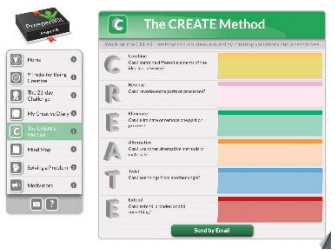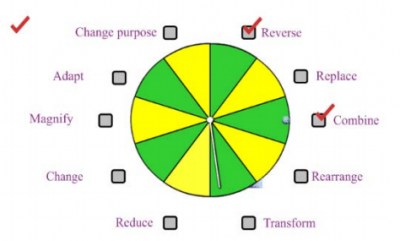Modification/OG
| Modification | |
| Contributors | Christian Kohls |
|---|---|
| Last modification | May 16, 2017 |
| Source | Kohls (2014)[1]; Kohls (2015)[2] |
| Pattern formats | OPR Alexandrian |
| Usability | |
| Learning domain | |
| Stakeholders | |
Also Known As: Variation (Variation)
Create something new by modifying existing objects or parts of them. Could you magnify, minimize, simplify or reshape its form?
Context
If you have already an existing product, a solution, a new idea or a prototype you should start thinking about improvements for this idea. Innovation rarely comes with a big bang but often means to do old things in better ways. Apple did not invent the phone but they certainly re-invented its form and uses.
Problem
With millions of options to form a solution it is very difficult to find the right ones. Stable forms are rare. However, sticking to existing forms is very conservative and does not lead to new ideas.
Forces
Evolution is based on many small random changes to existing forms. Every new breed is slightly different but new off-springs are not a new species.
Randomly draw lines on a piece of paper – will this drawing be an interesting form? Will it show an interesting solution path? Very unlikely! Now, take an existing form and iteratively re-draw it with modifications. After several iterations you may have something very different than the original form. But it is likely that you still have a form that makes sense. This process produces a better solution than the random approach. I once used the map of a landscape to illustrate the meaning of stable patterns that takes various forces into account. Not every path on such a map is stable. Drawing random strokes on the map will not lead from A to B because one does not obey the context. But based on an existing path one can easily explore different routes by modifying it step by step.
Solution
Therefore, systematically modify existing ideas or forms by variation of some properties while keeping the core form. Iterative modifications can lead to new forms that do not resemble the original form but are more stable than random forms.
- Identify the parts and properties of an existing solution.
- Think about modifications and variations for each of the parts and for the whole.
- New forms can emerge by substituting parts, magnifying parts, minifying parts, adding parts, removing parts… you name it!
- Reflect upon the modifications: Do they improve the solution? Do they stimulate new ideas?
- Which new properties (positive or negative) emerge if you apply the modification?
Example
Osborn tools and SCAMPER: Many Thought Triggers such as the Osborn tools set or SCAMPER (Substitute, Combine, Modify, Put into some other use, Eliminate, Rearrange) ask questions to stimulate thoughts about modifying a solution.
Variation by substitution: Can you replace some components by alternatives? Can you address new clients or target groups? Can you put your idea into another location? Can you substitute resources? Identify substitution questions for your own domain!
Modification by Magnification: The Smartphone market may be a good example where magnification can be observed: devices come in all sizes, with all variations of screen resolutions. But what else can be magnified to the benefits of users? Write down 20 ideas what can be extended, resized, or boosted for your own smartphone.
Other tools such as the morphological matrix use variation of parts or attributes to explore the solution space. ARIZ is another toolset which describes an “algorithmic” approach to solve problems and find new inventions; it is algorithmic in a sense that it describes specific analysis steps and several ways of modifying the problem or solution space.
Supporting Tools
Consequences
Unusual combinations of parts may trigger new ideas. New forms can emerge by substituting parts, magnifying parts, minifying parts, adding parts, removing parts… you name it! New forms will have new properties. These can be beneficial or a burden. We all know the saying: never change a running system. Improving an existing solution can be well intended but lead to undesired side-effects. Modifying only parts of a solution may limit the impact to local parts but very often it will influence the whole system – positively or negatively.
References
- ↑ Patlet published in Kohls, C. (2014). Dream teams at the right place. In Proceedings of the 19th European Conference on Pattern Languages of Programs (EuroPLoP 2014) (p. 3). New York:ACM.
- ↑ Pattern published in Kohls, C. (2015). Patterns for creative thinking: idea generation. In Proceedings of the 20th European Conference on Pattern Languages of Programs (EuroPLoP 2015) (p. 30). New York:ACM.

